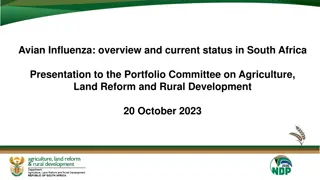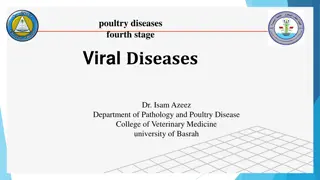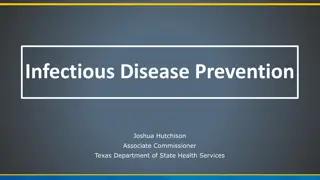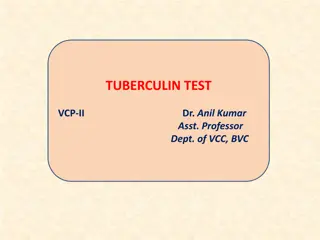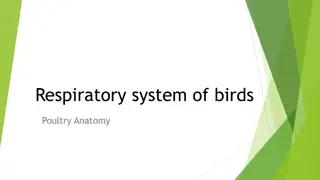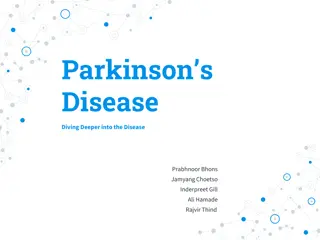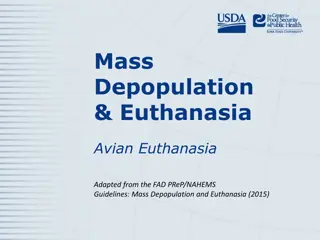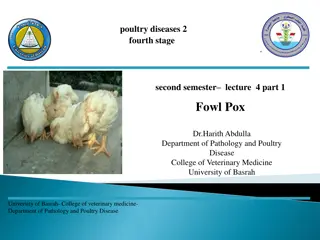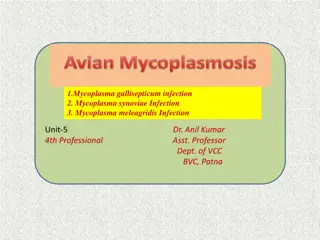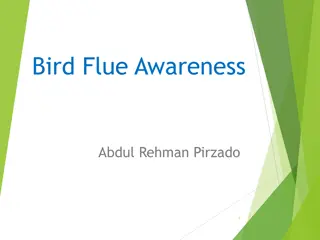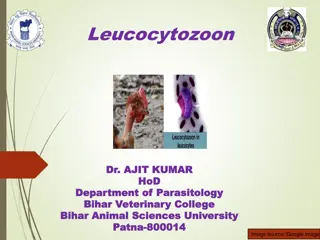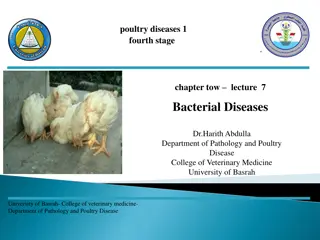Avian Hazard Advisory System (AHAS) Update
The latest updates to the Avian Hazard Advisory System (AHAS) providing crucial bird hazard information for flight safety. Learn about calculating NEXRAD risk, regional mosaics, flying areas, and risk management.
0 views • 23 slides
Understanding Steatotic Liver Disease: Importance, Epidemiology, and Pathology
Steatotic liver disease, including metabolic dysfunction associated steatohepatitis (MASLD) and metabolic associated alcoholic liver disease (MALD), is a common cause of liver test abnormalities in the United States. Risk factors such as obesity and metabolic syndrome can lead to advanced fibrosis a
2 views • 44 slides
Impact of Highly Pathogenic Avian Influenza 2023 on South African Broiler Industry
The presentation by the South African Poultry Association sheds light on the detrimental effects of Highly Pathogenic Avian Influenza (HPAI) on the broiler industry in South Africa. Factors such as load shedding, water supply interruptions, and now, the outbreak of H7N6, have exacerbated the financi
4 views • 19 slides
Innovations in Infectious Disease Control: Insights from Experts
Explore the latest advancements in infectious disease control through the lens of renowned epidemiologists and researchers. Delve into the impact of the COVID-19 pandemic, the historical prevalence of infectious diseases, and early infection prevention practices. Uncover the evolution of infectious
0 views • 22 slides
Avian Influenza Overview and Outbreak History in South Africa
Avian Influenza, specifically Highly Pathogenic Avian Influenza (HPAI) outbreaks in South Africa, have been documented since 2004, affecting primarily ostriches and poultry. Wild bird transmission remains a concern, with risk factors such as rainfall, temperature, wetlands, and poultry movements con
2 views • 25 slides
Overview of Poultry Diseases and their Causes
Poultry diseases caused by viruses and bacteria are a significant concern for poultry farmers. Viral diseases like Ranikhet Disease, Fowl Pox, and Avian Leucosis can have high mortality rates and severe symptoms. Bacterial diseases such as Tick Fever, Tuberculosis, Fowl Cholera, and Infectious Coryz
2 views • 12 slides
Understanding the Natural History of Disease Development and Prevention
The natural history of disease development outlines the progression of a disease in an individual without intervention, from exposure to outcome. Learning objectives include defining prevention terms, understanding disease severity, prevention levels, and intervention measures. Studying disease prog
4 views • 16 slides
Understanding Viral Diseases in Poultry: Newcastle Disease and Avian Influenza
Viral diseases like Newcastle Disease (ND) and Avian Influenza (AI) pose significant threats to poultry farming, impacting bird health and production. ND, caused by Avian paramyxovirus type 1, is highly contagious and manifests in various forms affecting birds' respiratory and nervous systems. On th
7 views • 24 slides
Best Neurosurgery Hospitals in India
Neuro diseases are very bad diseases. Many people are caught by Neuro diseases nowadays. It is related to brain diseases. Many people in India are caught by Neuro Diseases. It happens in Adults as well as children.\nA person of any age can be affected by this. Before this time very bad disease Named
1 views • 2 slides
Update on Avian Influenza A(H5N1) Outbreak in the U.S.
Avian Influenza A(H5N1) has been detected in domestic livestock and a few human cases have been reported in the U.S. The CDC issued a technical report detailing the cases and their symptoms. No human-to-human transmission has been identified so far. The situation is being closely monitored and updat
0 views • 17 slides
Update on Infectious Disease Prevention and H5N1 Vaccine Production
This content provides updates on infectious disease prevention efforts, including historical data, TB data posting schedule, and HIV surveillance updates. It also highlights the plans of the US Department of Health and Human Services to produce 4.8 million doses of the H5N1 avian flu vaccine for pan
0 views • 7 slides
Principles of Epidemiology: Understanding Disease Occurrence and Surveillance
Epidemiology is the study of disease patterns, factors influencing disease occurrence, and the core functions of surveillance, field investigation, and analytic studies. It involves understanding disease characteristics, natural history, and evaluating the effectiveness of activities to mitigate dis
1 views • 25 slides
Heart Health Jeopardy - Test Your Knowledge on Heart Disease
Test your knowledge on heart disease with this Heart Health Jeopardy game. Learn about heart disease facts, statistics, risk factors, and common types of heart diseases. Understand the importance of recognizing heart attack symptoms and the significance of factors like high blood pressure, high chol
0 views • 58 slides
Insights into Tyzzer's Disease: An Overview of a Bacterial Infection in Laboratory Animals
Tyzzer's disease is an acute bacterial infection affecting rodents and rabbits, caused by Clostridium piliforme. Discovered in 1917 by Ernest Tyzzer, the disease is characterized by necrotic lesions in the caecal mucosa, liver, and heart. Initially known as Bacillus piliformis, it was later renamed
2 views • 21 slides
Importance of Screening and Separation in Marburg Virus Disease Control
Early identification and separation of suspected Marburg virus disease patients play a crucial role in preventing the spread of the disease within healthcare settings. Screening and setting up specific areas for identification and isolation are essential steps to protect healthcare workers, patients
1 views • 15 slides
Foot and Mouth Disease: Overview, Symptoms, and Sequelae
Foot and Mouth Disease, also known as Aphthous fever, is a highly contagious viral infection affecting cloven-hoofed animals. It is characterized by the formation of vesicles and erosions in the mouth, nose, teats, and feet. The disease can cause a fall in milk yield, high fever, loss of appetite, a
1 views • 8 slides
Understanding Disease Control and Prevention in Epidemiology
This article discusses disease control processes in epidemiology, including reducing disease incidence, duration, and transmission. It covers public policy interventions, elimination, eradication, and extinction of infectious agents. It also highlights preventable causes of disease and different lev
2 views • 10 slides
Understanding Tuberculin Testing in Veterinary Medicine
Tuberculin tests have been vital in diagnosing latent and active tuberculosis in animals for over a century. Different methodologies and types of tuberculin, including avian and bovine, serve to differentiate between various forms of the disease. Procedures like the Single Intradermal Test (SID) are
0 views • 9 slides
Anatomy of the Respiratory System in Birds: A Detailed Overview
The respiratory system in birds, including poultry, consists of various components such as nostrils, nasal cavities, larynx, trachea, syrinx, air sacs, and lungs. Each part plays a crucial role in respiration, with unique features adapted to avian physiology. Understanding the anatomy of the avian r
1 views • 19 slides
Understanding Parkinson's Disease: Diving Deeper into the Neurodegenerative Disorder
Parkinson's disease is a neurodegenerative disorder that impacts dopamine levels in the brain. The history, epidemiology, causes, and pathophysiology of the disease are explored, shedding light on its significant impact on the nervous system. Genetic and environmental factors play a role in the deve
0 views • 25 slides
Guidelines for Avian Euthanasia and Mass Depopulation
Avian euthanasia and mass depopulation are crucial processes in animal health emergencies. This involves transitioning animals painlessly, maintaining welfare, and preventing disease spread. Methods such as injectables, inhalants, and physical methods are utilized, all aiming to provide a humane and
0 views • 22 slides
Understanding Fowl Pox in Avian Species: Causes, Symptoms, and Diagnosis
Fowl Pox, caused by Avipoxvirus, is a contagious disease in birds characterized by wart-like nodules and diphtheritic membranes in the throat and mouth. It has multiple forms, including dry pox, wet pox, and coryza-like form, with varying clinical signs. The disease spreads through mosquitoes, bitin
1 views • 10 slides
Dealing with Disease in Early Modern Britain
Explore the methods of treating disease in Early Modern Britain, including advancements in surgery by Ambroise Pare and Andreas Vesalius, the prevalence of quackery in medicine sales, and the impact of individuals like Lady Johanna St. John and Nicholas Culpeper. Evaluate the effectiveness of diseas
0 views • 8 slides
Screening for Peripheral Vascular Disease in Patients with Coronary Artery Disease
Patients with coronary artery disease should be screened for peripheral vascular disease as it is a frequent integrator of global cardiovascular risk. The association of atherosclerosis in various arterial diseases highlights the importance of identifying multisite artery disease. The prevalence and
0 views • 23 slides
Human Disease Symptom Network: Understanding Disease Relationships Through Symptoms and Genes
The Human Disease Symptom Network (HSDN) is constructed using a large-scale medical bibliographic records database to form a network of human diseases based on symptom similarities. By integrating disease-gene associations and protein-protein interaction data, correlations between symptom similarity
0 views • 37 slides
Understanding Mycoplasma Infections in Avian Species
Mycoplasma infections, caused by species like Mycoplasma gallisepticum and Mycoplasma synoviae, are common in poultry, particularly affecting turkeys and chickens. These infections lead to respiratory issues, sinusitis, and reduced production rates. Learn about transmission, clinical findings, and v
0 views • 13 slides
Avian Interactions with Wind Energy Development
The slides discuss avian interactions with wind energy development, highlighting challenges faced by bird species due to climate change. Strategies to minimize these interactions are explored, emphasizing the environmental benefits of wind energy and comparing avian fatality rates with other enginee
0 views • 19 slides
Understanding One Health Approach for Food Security and Public Health
The concept of One Health emphasizes the interconnectedness of human, animal, and environmental health. This approach explores how animal-borne illnesses impact food security, public health, and overall well-being. By examining diseases like avian influenza, Newcastle disease, and brucellosis, we se
0 views • 15 slides
Understanding Avian Influenza: Symptoms, Diagnosis, and Prevention
Avian influenza, or bird flu, is a viral disease affecting birds' respiratory, digestive, and nervous systems. It presents in two forms - Highly Pathogenic Avian Influenza Virus (HPAIV) and Low Pathogenic Avian Influenza Virus (LPAIV). The virus has two important surface antigens, Hemagglutinin (H)
0 views • 7 slides
Understanding Bacterial Diseases of Fish: Columnaris Disease Overview
Columnaris disease, also known as Saddleback disease, is a common bacterial infection in fish that is often brought about by poor handling and high stress levels. This disease manifests as tail and fin rot, leading to rapid fish mortality. The causative organism, Cytophaga (formerly Flexibacter), is
0 views • 21 slides
Understanding Avian Influenza: Symptoms, Transmission, and Prevention
Avian influenza, commonly known as bird flu, is a contagious disease caused by flu viruses that primarily affect birds but can also spread to humans. Learn about the symptoms in humans, how the virus spreads, and preventive measures to stay safe. Stay informed and take necessary precautions to reduc
1 views • 15 slides
Decoding Genetics: Insights from Alzheimer's Disease Symposium to Type 2 Diabetes Study
Explore the latest findings from the Alzheimer's Disease Genetics Symposium 2019 on disease mechanisms, drug targets, and genetic pathways. Dive into the progress made by the Alzheimer's Disease Genetics Consortium over the past decade. Transition to a Genome-Wide Association Study uncovering suscep
0 views • 42 slides
Birds of Girinagara: A Study on Avian Species and Habitats
Documenting and analyzing the bird life in Girinagara, this study captures various species such as Pale Billed Flowerpecker and Red Whiskered Bulbul. With detailed observations of their activities and habitats, the research sheds light on the rich avian diversity present in the area.
0 views • 11 slides
Liver Disease Burden in Tower Hamlets
Dr. Somen Banerjee, Director of Public Health in London Borough Tower Hamlets, highlights the concerning liver disease mortality rates in the area, with high incidence of cirrhosis, cancer, and hepatitis B and C. The data reveals a significant burden of liver diseases such as Non-Alcoholic Fatty Liv
0 views • 18 slides
Understanding Inflammatory Bowel Disease: Crohn's Disease and Ulcerative Colitis
Inflammatory Bowel Disease (IBD) encompasses Crohn's disease (CD) and ulcerative colitis (UC), chronic conditions with immunologic basis. This article delves into the epidemiology, pathophysiology, and differences between CD and UC, highlighting clinical features, pathology, and complications like a
0 views • 42 slides
Leucocytozoon: Haemoparasite in Birds from Bihar Animal Sciences University
Leucocytozoon, a haemoparasite found in birds, is studied at Bihar Animal Sciences University under Dr. Ajit Kumar. The parasite's morphology, life cycle, and host interactions are detailed, providing valuable insights into its impact on avian health. The research sheds light on the genus Leucocytoz
0 views • 13 slides
Ultrastructural Alterations of Renal Tissue in a Male Patient with Fabry's Disease
Fabry's disease is a rare X-linked lipid storage disorder characterized by deficient lysosomal alpha-galactosidase A activity. This condition primarily affects males, leading to chronic kidney disease and progression to end-stage renal disease. Kidney involvement is a critical aspect, and high doses
0 views • 24 slides
Understanding Influenza: From Pandemics to Avian Flu Outbreaks
Influenza is a viral respiratory illness that can range from seasonal flu to pandemic outbreaks like the 2009 swine flu (H1N1) epidemic. The dangers and prevention methods of specific strains, such as H5N1 avian flu, have been witnessed since 2003. This summary delves into the characteristics, impac
0 views • 13 slides
Understanding Viral Pathogenesis: Causes and Consequences
Viral pathogenesis involves the process by which a virus leads to disease, exploring the interplay between viral and host factors. It encompasses the concepts of virulence, viral disease, and the effects on infected cells and the host's immune response. Changes within infected cells, including cell
0 views • 26 slides
Understanding Avian Salmonellosis in Poultry: Causes, Symptoms, and Prevention
Avian Salmonellosis, a bacterial disease in poultry, is categorized into distinct forms such as Pullorum Disease, Fowl Typhoid, and Paratyphoid Infection. It is characterized by high mortality rates, affecting both young chicks and mature fowls. The disease spreads through infected eggs, leading to
0 views • 11 slides




